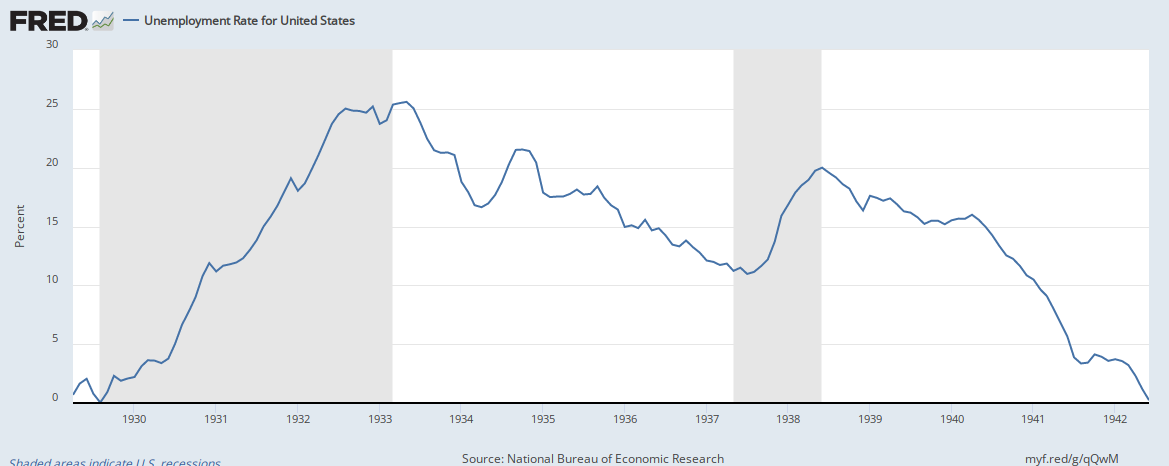Coronavirus: Are We Fighting a Great Depression or Causing One?

Unemployment lines during the Great Depression pale to what we’ve seen over the past six weeks. | Source: National Archives at College Park / Public domain
- U.S. unemployment has hit 30.3 million people.
- This will push next week’s official unemployment rate well about 13%.
- Unemployment during the Great Depression was above 14%.
The longer U.S. unemployment rises due to our response to coronavirus, the greater our depression, all the way to the Great Depression. COVID-19 causes physical anguish and death, but our economic response also causes mental anguish and death.
Suicides increased during the Great Depression. Suicide mortality peaked with unemployment, in the most recessionary years.
The great despair of the Great Depression and high suicide rates were due almost entirely to job losses , and we are approaching those record job losses now.
Fighting Great Depression Or Causing One?

The pain is real . The economy contracted nearly 5% in the first quarter due to the coronavirus lockdown, and it is estimated to reach several times that high in the second. As a result, U.S. unemployment has hit 30.3 million people in just six weeks.
The pain facing many Americans was on stark relief Thursday morning. Nearly 3.8 million people filed for unemployment benefits for the first time in the most recent week, the Labor Department said. That topped the consensus forecast among economists…. The new tally shows that over 30 million Americans have lost their job since the start of the coronavirus pandemic.
The total number of jobs created since the Great Recession has now been wiped out. As of this week, our coronavirus lockdown has raised unemployment to levels barely beat by the Great Depression.
We are beating other unemployment records. The U.S. unemployment rate is a little slower to be reported than the total number of unemployment claims, but the previous week already set a record :
The number of people currently receiving unemployment insurance as a percentage of the labor force, was 12.4% for the week ending 18 April , the highest percentage recorded since the department started releasing those figures.
If you add up all the new filings in the last six weeks, 18.6% of the labor force has applied for benefits.
Real Unemployment Worse Than the Numbers
The percentage of the workforce continuing to receive unemployment insurance (the unemployment rate) is smaller than the number just mentioned who have applied and been approved. It is also smaller than the percentage of the workforce actually unemployed.
Millions go unreported. Official statistics do not count the many who became unemployed due to the coronavirus shutdown who were not eligible for unemployment benefits.
Some people are not eligible because they haven’t been working long enough. Some because they have used up all their benefits and have fallen off the roll.
But there’s a unique factor right now due to the sudden impact of the coronavirus shutdown. For several weeks, state unemployment agencies were not able to process unemployment claims fast enough , though those backlogs are starting to decline.
The figures are also still undercounting the number of people out of work. Some states are still dealing with backlogs of claims after their systems were overwhelmed by the massive volume of applications.
Estimates range from another 9 to 14 million people still trying to claim unemployment benefits.
Unemployment Is Reaching Great Depression Records
Records were not kept during the Great Depression by the same measures used now, and present records leave many out. That makes an exact comparison in employment statistics impossible.
There was, for example, no nationwide unemployment insurance plan tracking the unemployed during the Great Depression. The first nationwide unemployment insurance did not become law until late 1935 . By that time, the nation was well past the peak unemployment of the Great Depression.
The general level of unemployment throughout the Great Depression was only a little higher than today’s numbers :
The highest rate of U.S. unemployment was 24.9% in 1933, during the Great Depression. Unemployment remained above 14% from 1931 to 1940…. During the Great Recession, unemployment reached 10% in October 2009.
That 14% rate is not much higher than the latest publicized “insured unemployment rate” of 12.4% . That will jump higher when the official rate gets adjusted again next week.
The Federal Reserve shows peak unemployment in the Great Depression at 25.59% in May 1933.

Is the Coronavirus Lockdown Worth It?
Everyone’s first response is that you cannot compare the value of saving human lives via a pandemic lockdown to economic costs. However, that ignores the ultimate cost in human lives and pain that will be due to unemployment.
Many economists are realizing unemployment is going to last longer than just a few months. The longer the lockdown continues, the greater the unemployment numbers, but also the slower the recovery on the other end as businesses die off.
The Great Depression brought a human cost of suicide, depression, loss of human dignity, and hunger that scarred the human psyche for a hundred years. It became a life-story of human suffering equal to the war stories of WWII.
Given the pain and suffering we reached in the Great Depression due to unemployment, I think we need to ask, “Is the coronavirus lockdown worth it?”
Disclaimer: The opinions expressed in this article do not necessarily reflect the views of CCN.com.